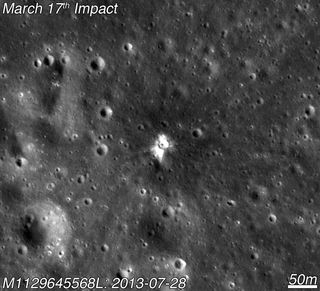Moon's Newest Crater Revealed in Crash-Site Photo

When a space rock slammed into the moon earlier this year, it tore a big new hole in the already pockmarked lunar surface and generated an explosion that would have been visible to the naked eye from Earth, scientists say.
New images of the moon crater from NASA's Lunar Reconnaissance Orbiter (LRO) show that this hole stretches 59 feet (18 meters) across, with radiating steaks of debris from the impact covering an area half the size of a football field, according to the website Spaceweather.com.
Scientists first noticed the lunar impact earlier this year while poring over LRO photos from March 17, 2013. The researchers spotted a bright flash of light at the impact area — 10 times brighter than any impact they had seen since they started monitoring the moon for meteor crashes in 2005. When the discovery was announced in May, the team said a meteoroid the size of a small boulder likely hit the lunar surface at an astounding 56,000 mph (90,000 km/h). [The Greatest Moon Crashes Ever]
The orbiter's LROC camera snapped new photos of the crater in July as the spacecraft flew over the impact site, which is in a large plain in the moon's northern hemisphere known as Mare Imbrium ("Sea of Showers"). By analyzing the images, scientists determined that the rock responsible for the impact was 0.65 feet (0.2 meters) wide, Spaceweather.com reported. The researchers presented their findings last week at the annual meeting of the American Geophysical Union in San Francisco.
Earlier this year, scientists said the space rock that gouged the new hole in the moon may have been related to a meteor shower over Earth at the same time.
"On the night of March 17, NASA and University of Western Ontario all-sky cameras picked up an unusual number of deep-penetrating meteors right here on Earth," Bill Cooke of NASA's Meteoroid Environment Office said in a statement in May. "These fireballs were traveling along nearly identical orbits between Earth and the asteroid belt."
The Earth's atmosphere acts like a shield against impacts from small space rocks, which often slow down, burn up and break apart before they hit the ground. Surrounded by the airless vacuum of space, the moon lacks such protection, making meteoroid strikes quite common.
Get the Space.com Newsletter
Breaking space news, the latest updates on rocket launches, skywatching events and more!
Over the last eight years, NASA's moon impact-monitoring program has spied more than 300 flashes of light, interpreted as space rocks slamming into the lunar surface. LROC's principal investigator Mark Robinson wrote in a post on the project's website: "This is not the first new impact crater the LROC team has found, nor will it be the last!"
The flash of light in the LRO images comes from the glow of molten rock and hot vapors at the impact site, not fire, according to NASA. (Since the moon has no oxygen, there is no combustion involved in its meteor crashes.)
Follow Megan Gannon on Twitter and Google+. Follow us @SPACEdotcom, Facebook or Google+. Originally published on SPACE.com.
Join our Space Forums to keep talking space on the latest missions, night sky and more! And if you have a news tip, correction or comment, let us know at: community@space.com.

Megan has been writing for Live Science and Space.com since 2012. Her interests range from archaeology to space exploration, and she has a bachelor's degree in English and art history from New York University. Megan spent two years as a reporter on the national desk at NewsCore. She has watched dinosaur auctions, witnessed rocket launches, licked ancient pottery sherds in Cyprus and flown in zero gravity on a Zero Gravity Corp. to follow students sparking weightless fires for science. Follow her on Twitter for her latest project.
